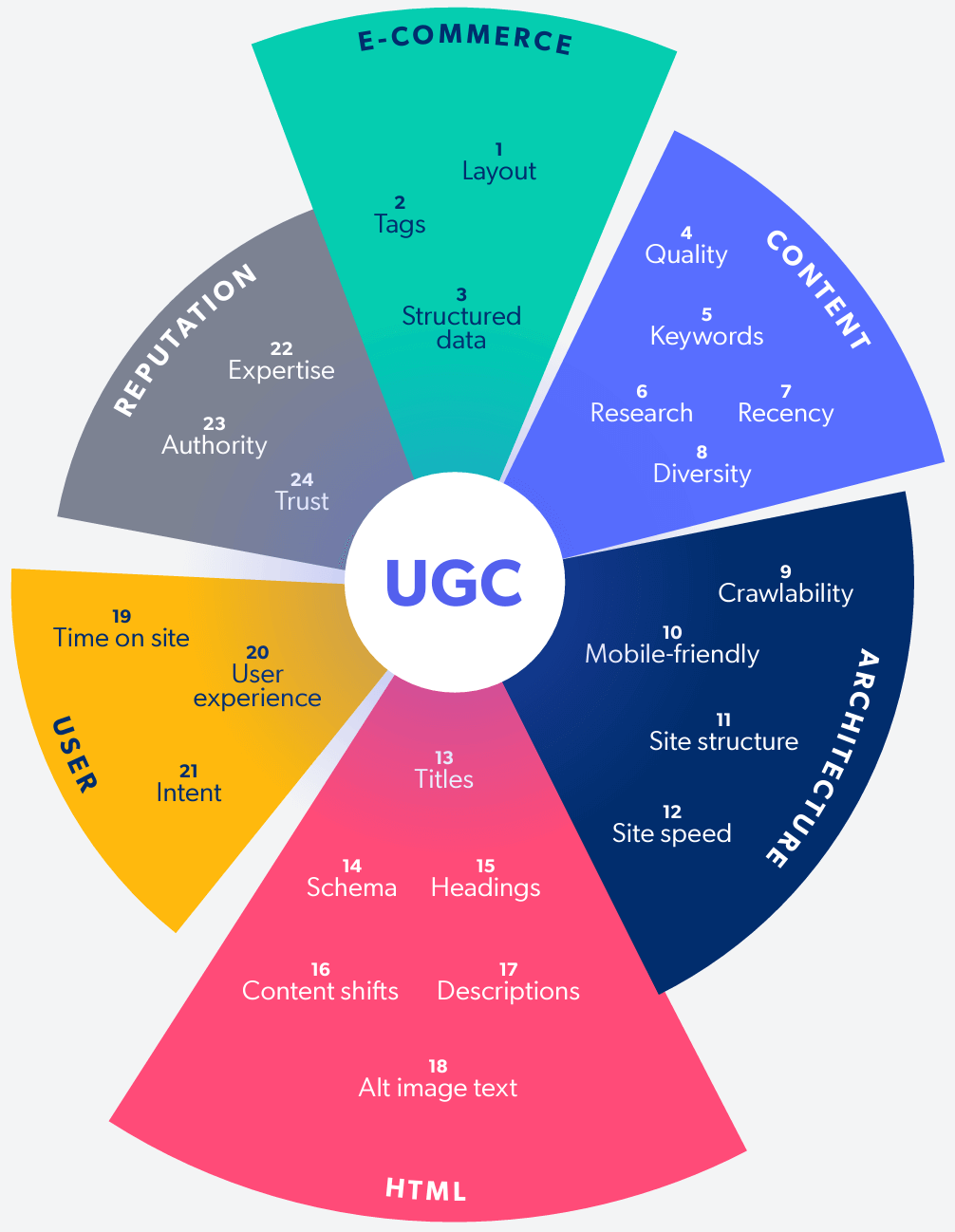June 30, 2023
In the ever-evolving digital retail landscape, search engine optimization (SEO) continues to play a pivotal role in driving organic traffic, visibility, and sales — particularly for retail websites.
While content still rules, retailers need a holistic SEO strategy that optimizes mobile and voice search, diversifies marketing channels, and maintains technical excellence.
SEO tips for retail growth
Looking to boost your online presence? Here’s our 10 SEO tips for retail.
- Do your keyword research
- Feature content that positively impacts SEO
- Refresh your existing content
- Diversify your marketing channels
- Optimize return on ad spend
- Be mobile-first
- Consider voice search
- Check technical SEO
- Include structured data
- Secure your e-commerce site
1. Do your keyword research
Your retail SEO strategy should begin with keyword research. You want to make sure you’re targeting the right words in your on-page content in order to maximize your SEO efforts. But where do you start?
- Understand your audience: Research and identify the keywords and phrases your target audience is likely to use when searching for products similar to yours. And don’t forget to check reviews — they often contain valuable insights into how people talk about your products and can help you better understand your customers’ language
- Focus on long-tail keywords: Long-tail keywords are more specific, typically have less competition, and attract more qualified traffic. For example, a keyword like “dresses” is broad and vague, while the long-tail keyword “women’s maxi dresses for summer” targets a narrow audience with clear intent
- Identify user intent: Evaluate the search queries related to your products and identify the intent behind those searches. Are the terms you’re using informational, navigational, or transactional? Words like ‘buy,’ ‘shop,’ ‘order, and ‘discount’ signal strong transactional intent. Including them in your keyword choices can help you target users actively seeking to make a purchase
- Monitor competitor keywords: Keep an eye on the keywords your competitors are targeting to help you identify gaps or opportunities in your keyword strategy
Remember that effective keyword research is an ongoing process. You need to stay updated on the latest industry trends and adapt your keyword strategy to stay competitive in online retail.
2. Feature content that positively impacts SEO
Prioritizing quality content attracts traffic to your store and distinguishes your business from competitors. You already know that user-generated content can boost your add-to-cart rate, but it can also improve your E-E-A-T signals.
E-E-A-T stands for Experience, Expertise, Authoritativeness, and Trustworthiness. These four qualities are part of Google’s Search Quality Rater Guidelines, which real people use to evaluate the quality of search results. To meet these quality standards for SEO, your content must be high-intent, valuable, engaging, and useful to searchers.
While it’s not a direct ranking factor, Google wants to serve its users results with strong E-E-A-T, which is why it must be a key component of your SEO strategy.
So what type of content best contributes to E-E-A-T? User-generated content (UGC). Studies show that UGC can boost organic traffic by 30% — one of the 24 ways UGC can boost SEO.
The most effective types of UGC for SEO include:
- Product reviews. Product reviews are one of the most influential elements of e-commerce sites, with 88% of consumers reading them before making a purchasing decision. Including product reviews on your product detail pages (PDPs) can improve their overall quality, enhance their trustworthiness, and send positive signals to search engines
- Visual content. Visual UGC, like photos and videos, can enhance your site’s trustworthiness by showcasing real people, real experiences, and real satisfaction with your products. It creates a more genuine and reliable connection with shoppers, boosting their confidence in your site and increasing the likelihood of conversion
- Questions and Answers. Q&As contribute to E-E-A-T by providing accurate and valuable information to customers and actively engaging with their inquiries. This showcases your expertise and helps improve your reputation, credibility, and, ultimately, customer trust
3. Refresh your existing content
Search engines prioritize fresh, relevant content. That means older content is likely to drop in rankings and traffic. Make sure to update your existing content on a regular basis! That’s another way UGC can help.
Keeping up with the content demands can be a challenge, but shopper content like photos, videos, reviews, and Q&As ensures you’ll have a steady stream of new content and can provide several SEO benefits, including:
- Improved SERP results: Refreshing content helps search engines discover updates and changes on your product pages, leading to improved Google search engine results page (SERP)rankings
- Keyword optimization: Optimizing keywords in refreshed content increases the likelihood of ranking higher in search results for relevant terms
- Enhanced user experience: Updating content improves the user experience, resulting in longer on-page dwell time, lower bounce rates, and higher conversion rates, which all positively impact search rankings
- Increased relevance: Keeping content relevant and accurate through refreshes helps search engines understand the usefulness of your product pages, increasing their visibility in search results
- Social sharing and backlink opportunities: Refreshed content attracts social sharing and backlink opportunities, signaling to search engines that your content is valuable and deserves higher rankings
Keep in mind refreshing content doesn’t guarantee instant results in search rankings. SEO is a long game with complex factors. But by consistently updating and optimizing your product detail pages (PDPs), you can increase the likelihood of better visibility and improved organic search performance over time.
4. Diversify your marketing channels
Diversifying your marketing channels can have several positive effects on SEO for your retail website. By leveraging social media, email marketing, and working with influencers, you can get more people to visit your e-commerce site and interact with your content, improving your search engine ranking.
Plus, using different methods means you’re not relying on just one way to drive traffic. It can help you stay ahead of algorithm changes and keep a steady flow of visitors and sales.
5. Optimize return on ad spend by lowering advertising cost
SEO and paid ads help your e-commerce site show up in search results without spending as much on ads. As a retailer, you can improve your marketing campaigns and still achieve good results by refining ad targeting and using data analysis to limit spending on ads that don’t work. By balancing SEO and cost-effective advertising, you’ll get more value for your advertising dollars and improve your overall marketing results.
You can improve online visibility and increase revenue by pursuing a holistic search strategy. And by combining SEO and SEM, you can dominate Google’s SERP. One way to do this is by redirecting ad spending from keywords where you already rank well organically. It allows you to maximize your budget and achieve better results.
6. Be mobile-first
As of 2023, 79% of smartphone users have made purchases using their mobile devices. And it’s projected that in 2024, smartphone commerce will account for 44% of all e-commerce sales.
With this significant shift toward mobile commerce, retailers need to implement a mobile-first approach. A mobile-first approach ensures your site is optimized for mobile screens and provides a seamless user experience, leading to more organic traffic. Factors such as responsive design and intuitive navigation also enhance user satisfaction and decrease bounce rates.
Not to mention, a mobile-friendly website is more likely to attract backlinks and social shares, as shoppers are more inclined to share content they can easily access on their mobile devices.
7. Consider voice search
Voice search is becoming increasingly important for SEO in retail thanks to the rise of voice-activated virtual assistants like Siri, Alexa, and Google Assistant. Voice search offers convenience and speed, allowing users to perform hands-free searches and get immediate results.
With voice search queries often have a conversational tone and are longer, resembling natural language. Retailers need to optimize their content with long-tail keywords, answering common questions, and providing concise, informal responses.
By embracing voice search, retailers can capture a growing audience and gain a competitive edge in the evolving search landscape.
8. Check technical SEO
As a retailer, here’s five tasks you can undertake to improve your technical SEO and optimize your online presence:
- Optimize website performance: Improve your site’s speed, responsiveness, and user experience for enhanced performance
- Resolve technical errors: Identify and fix technical issues such as broken links, duplicate content, and 404 errors for better site functionality
- Establish logical site architecture: Create a well-organized site structure and implement proper internal linking for improved navigation and crawlability
- Optimize for website accessibility: Ensure your site is accessible to all users, including those with disabilities, by following accessibility guidelines
- Streamline indexing: Optimize your site’s crawling and indexing potential by leveraging XML sitemaps and robots.txt directives
9. Include structured data
Structured data is information that’s decipherable by machine learning algorithms. Retailers can leverage it to enhance SEO efforts by providing search engines with clear and structured information about a product’s name, price, availability, ratings, and reviews to search engines.
This enriched data helps search engines understand and categorize products more accurately, improving search results’ visibility and potential inclusion in rich snippets and product carousels.
Structured data can also help you showcase additional information, such as product variations, specifications, and shipping details, enhancing the user experience and increasing click-through rates. By incorporating structured data, you can gain a competitive edge, attract more targeted organic traffic, and drive higher engagement and conversions.
10. Secure your e-commerce site
Last but certainly not least, securing your e-commerce sites is essential. Since search engines prioritize secure sites, implementing SSL encryption and ensuring your site is secure can positively impact your search rankings and conversion rate.
And because customers are more likely to trust and make purchases from a secure site, it also improves the user experience and can increase conversions.
Dominate SEO for your retail website
Mastering SEO is crucial for driving traffic, visibility, and sales in the dynamic digital retail world. By implementing these 10 SEO tips for your retail site, you’ll elevate your online presence and outshine the competition.
To maximize your online presence as a retailer, consider the following SEO tips:
- Conduct thorough keyword research to target the right audience and diversify your marketing channels for broader reach
- Prioritize quality content that aligns with Google’s E-E-A-T standards and refresh existing content to improve search rankings
- Focus on technical SEO to strengthen your site’s foundation, leverage structured data for enhanced visibility, and secure your e-commerce site for customer trust
With these strategies in place, you can navigate the SEO landscape with confidence and achieve sustainable success in the digital retail realm!
Want to really hone your SEO strategy? Watch our short masterclass below to understand what UGC criteria to include in your SEO audit, how to boost your Instagram SEO rankings, and the factors that affect your retail category search ranking.










